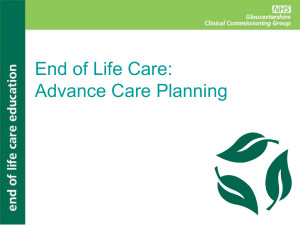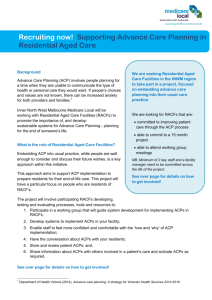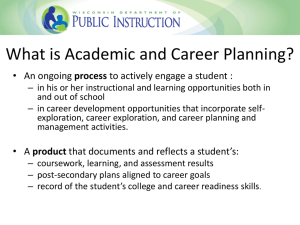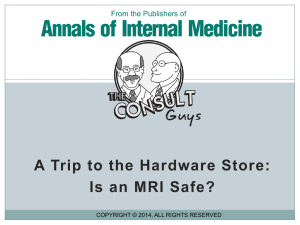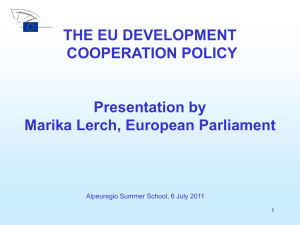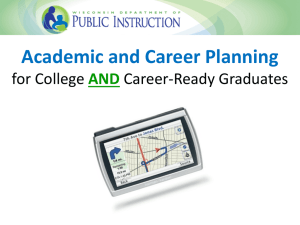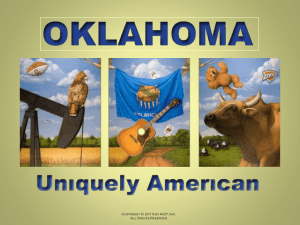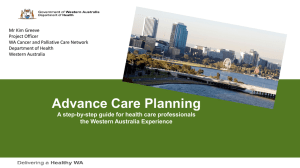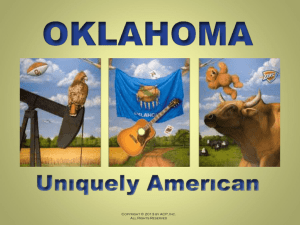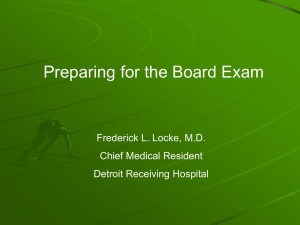ACP Presentation - Wisconsin Statewide Transition Initiative
advertisement
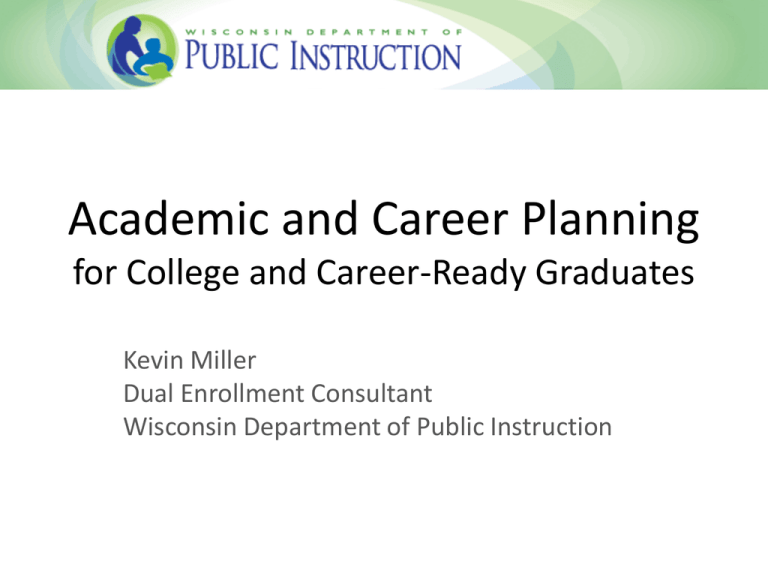
Academic and Career Planning for College and Career-Ready Graduates Kevin Miller Dual Enrollment Consultant Wisconsin Department of Public Instruction Agenda: • Diamonds in the Rough • Setting the Table • Overview of Academic & Career Planning (ACP) • A Shift • The ACP-Transition Connection • Questions Diamonds in the Rough Consider the Diamond • Laid out on a soft cloth or viewed through a magnifier • Set amongst other beautiful gems • Set in a ring, necklace, or earrings • The Hope Diamond or the Crown Jewels • Maybe industrial applications The Rest of the Story • The beauty and/or utility requires extensive processing by skilled craftspeople • There is natural beauty before refinement, but there is also great potential • The right person with the right skills can bring out the potential Children as Diamonds • Genetics and early nurturing form unique characteristics of each child • There is natural beauty in each child • Children bring smiles and joy • Children hold incredible potential, but it is sometimes hidden deep inside Finding the Potential • Good teachers – like good jewelers –look deeply and carefully at each student • They find the unique characteristics • They apply different tools and techniques tailored to the unique characteristics • They constantly reassess and adapt their approach for each child Some Have Personal “Jewelers” • Receive refinement and polishing outside of school • Caring nurturing adults • Surrounded by books, reading, etc. • Challenged by games and activities • Access to camps, trips, cultural events, sports, drama, clubs, etc. Schools not Always Conducive • Increasing academic demands • Directed or mandated instruction and assessments • Limited time to carefully discover each student’s unique characteristics • Limited opportunities to develop meaningful, trusting, mutually respectful relationships Opportunities Better than Ever • • • • • Web-based and other technology tools New ways to deliver instruction New contexts for students to learn Increasing acceptance of innovation Academic and Career Plans and ACP Planning Process ACPs – Polishing for Every Child • ACP only as good as process that created it • Generic diamond cutting instructions won’t achieve max potential for most diamonds • Same is true for students • Caring adult needs time to discover student characteristics, guide development of personalized ACP, then bring the ACP to life Strength and Beauty • Regardless of treatment (neglect, abuse, or just poorly skilled craftspeople), diamonds remain strong with potential for beauty • Humans are the same, however… • Both can be crushed beyond repair if subjected to enough of the wrong types of pressure ACPs as a Means to Success • • • • Caring Adult relationship Self-Awareness and discovery Vision, skills, desire Achieving potential and satisfaction Setting the Table for ACPs Challenges Facing Schools: • Pervasive achievement gaps • High drop-out/low graduation rates in some places • Post-secondary school performance – High need for remedial coursework – Poor program completion rates • Skills gaps • Low CTE enrollment • Truancy and student conduct concerns What’s Been Tried: • “Bring to scale” successful initiatives • Increased academic instruction • District-wide, school-wide, program-wide “reforms” and initiatives • Initiatives based on test scores • Academic standards and standardized assessments The Results: • • • • • Incremental improvements Occasional successes Strained resources Initiative overload And… ACP Overview The World Before ACPs The World with ACPs • Students have a realistic vision of their future • Students know the skills, knowledge, and habits needed to achieve that vision • Students have access to the instruction needed to develop the skills, knowledge, and habits • Students are an active participant in determining how to meet their needs What is Academic and Career Planning? • An ongoing process to actively engage a student : – in his or her instructional and learning opportunities both in and out of school – in career development opportunities that incorporate selfexploration, career exploration, and career planning and management activities. • A product that documents and reflects a student’s: – coursework, learning, and assessment results – post-secondary plans aligned to career goals – record of the student’s college and career readiness skills. Each student’s process: • • • • Who am I? (Know) What do I want to do? (Explore) How do get I there? (Plan) Let’s GO! (Implement) Why Academic and Career Planning? 1. RESEARCH! Students with a future focus show: a) b) improved motivation, engagement in school, academic performance, relevant course selection, understanding post-secondary options; and engage in decreased risk-taking behaviors. 2. ACPs are identified as best practice in the WI comprehensive school counseling standards & in the WI Digital Learning Plan. 3. Academic and Career Planning adds relevance to other initiatives (i.e. personalizing learning, PBIS, RtI, Dual Enrollment, Youth Options). 4. WI Statute 115.28(59) supports Academic & Career Planning Student Learning Plans: Supporting Every Student's Transition to College and Career Rennie Center for Education Research and Policy, June 2011. School Connectedness: Strategies for Increasing Protective Factors Among Youth Centers for Disease Control and Prevention, 2009. Wisconsin Statute 115.28(59) • Includes $1.1 million in 2014-2015 funding for software technology and professional development supporting statewide implementation of ACP. • Authorizes DPI to create administrative rule with requirements for ACP services for all students in grades 6-12 by 2017-18. A Shift 4-Year Plan (Traditional) ACP (Now) Product-based Process-based Some or select students All students Acts as a 4-year plan of courses Acts as a navigational tool for students from grade 6-12 and beyond Student “on own” for its development Student-driven with collaboration (mentor and parents) HS Graduation = End point HS Graduation = Check point Student adapts to offerings Options adapt to student needs Career development is only the school counselor’s job. Career development is a systematic, wholeschool responsibility. ACP Process Components: • KNOW – Self awareness (i.e., interests, aptitudes, strengths, weaknesses, passions) – Exploration activities (i.e., interest inventories, reflection exercises) – Vision development – Individual goal-setting • EXPLORE – Career awareness assessments and activities – Career research – Occupational and career experiences (i.e., investigative interviews, job shadows, paid or unpaid work experience) ACP Process Components Include: • PLAN – Connect instructional activities with the education and preparation needed to successfully enter a particular field of interest – Work-based learning opportunities – Extra-curricular and community-based learning experiences – Postsecondary training options – Financial plan • IMPLEMENT – – – – – Update Quarterly (at least) Adapt/Modify Intentional Sequence of Courses Adapt/Modify Personal Goals Adapt/Modify Career Goals ACP Conferencing Select ACP Resources Work-based Learning Dual Enrollment Programs of Study ACP Resources In Development ACP Webpage ACP Listserv ACP on Facebook & Twitter ACP Software ACP Guidance (K-12) ACP Guidance (parents) ACP Guidance (community) ACP Guidance (business) ACP Challenges • • • • Buy in Student engagement Current structure of our schools A shift in how we approach career development Quality Academic & Career Planning • Includes and reinforces strong relationships between students and the mentors/adults in their lives • Increases the connections between student self-awareness, daily instruction, and career/college goals • Shows positive outcomes—students are more engaged and autonomous in school • Enhances student resiliency to overcome challenges & changes • Provides qualitative and quantitative data regarding college and career readiness paths ACP Navigation Goal All students understand themselves, explore their world, establish goals for their futures, and create a plan to achieve their goals; while realizing that alternative routes or temporary roadblocks can mean that a recalculation is necessary on one’s journey. The ACP-Transition Connection • All students must transition, but… • Certain students are required to have a transition plan • ACPs = Transition Plans for all students with… • All school staff dedicated to implementation • In other words, ACPs will improve numerous outcomes for all students, including SWD Questions? Kevin Miller Dual Enrollment Consultant; WI Department of Public Instruction kevin.miller@dpi.wi.gov 608-267-3161


